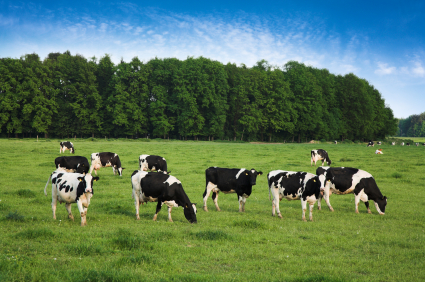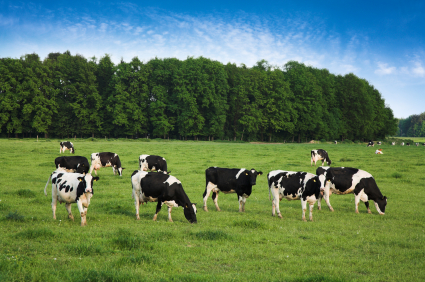As the National Organic Standards Board considers new rules (PDF) on organic dairy, a dispute has erupted between watchdog group Cornucopia Institute and widely respected Straus Family Creamery in Northern California over the access-to-pasture standard. (The Marin Independent Journal recently ran an informative account of the conflict.) E. Melanie Dupuis, author of Nature’s Perfect Food: How Milk Became America’s Drink, brings an historical perspective to the conflict.
———————————
 There’s a politics to everything–even a buch of cows munching grass.
There’s a politics to everything–even a buch of cows munching grass.
Editor’s note: The original version of this post contained three factual errors. The Cornucopia Institute did not give Straus Family Creamery and Aurora dairy the “same rating” with regard to sustainality practices, as the article stated. Cornucopia gave Straus “three cows” of a possible five and Aurora zero. And California dairy farmer Tony Azevedo is not the “one organic dairy farmer” on Cornucopia’s board of directors. Azevedo serves on the group’s “Policy Advisory Staff,” not its board of directors. The board’s one dairy farmer is Ann Lazor of Vermont’s Butterworks Farm. I regret these errors, and have deleted them in the text below. —Tom Philpott
—–
Consumers interested in understanding the current fight over what makes milk “organic” would do well to study the politics of the dairy industry a century ago.
In the 1930s, dairy farmers in the Northeast and Midwest spilled milk onto the streets to protest prices. Their political rhetoric blamed shady milk dealers and heartless bureaucrats for their plight but, as I describe in my book, Nature’s Perfect Food, there was another factor that increased the chaos of dairy pricing: pasture.
There were two kinds of dairy system at the time: larger, more intensive, dairies closer to cities that fed grain and hay in confinement operations and sold milk to fluid milk markets year round. Then, there were the smaller, “hill farms” that tended to pasture their cows. Known as “summer dairies” these pasture-based operations tended to sell milk mostly in the summer months, often to local small cheese plants.
Hill farm costs were low, and so were the prices cheese plants paid for their milk, compared to higher priced fluid market milk. However, when times got tough, some of this pasture-produced cheaper milk would make its way into city fluid milk markets, thereby lowering the price paid to higher-cost confinement dairy farmers. In 1937, Congress passed legislation that allowed for the creation of milk market orders, boundary-setting rules that helped separate out confinement and pasture based operations and the prices they received.
Eventually, pasture-based summer dairy systems died out in all but the most remote areas of the Midwest. Making cheese and other dairy products increasingly became the strategy dairy companies used to manage the supplies they couldn’t sell as fluid milk.
The rise in consumer demand for organic milk brought pasture-production back into the game. Along with the re-appearance of pasture-dairying has come the tricky politics of pasture as well. After more than two years of wrangling, the USDA’s National Organic Program is about to release its final Livestock Access to Pasture Rule. What the final rule will look like is uncertain, but the proposed rule, printed in the Federal Register in October of 2008, mandates that cows producing certified organic milk have a specific percentage of pasture-grazed grass as part of their diet. Two years of negotiations have brought most actors into agreement as to minimum national pasture requirements. But two parties: Straus Family Creamery and Aurora Dairies, continue to fight.
“A sustainable agroecosystem maintains the resource base upon which it depends,” according to agroecologist Steve Gliessman, which means that a sustainable agricultural production system is specific to the particular bioregion in which it exists. This is certainly true when it comes to pasture; the number of days of available green grass in any one place is dependent on soil, water, weather, hilliness, and a number of other factors that vary from one region to the next. Yet the proposed organic rule sets a national floor for the amount of pasture a cow must eat to be considered as producing organic milk. There are some temporary exceptions, but temporary flexibility is not the same as flexibility to allow for regional variation in pasture production systems.
Albert Straus is one of the pioneers of organic dairying. Straus Family Creamery, which milk a few hundred cows and buys the milk of two other small local dairies, was the first certified organic dairy company west of the Mississippi. Straus’ local Bay Area following is intense, and a number of his consumers submitted comments to the USDA on the proposed rule defending Straus’ position. Straus’ issue with the rule is not pasturing per se, but the fact that his dairy is located in the Marin Agricultural Land Trust, and regulated by the California Regional Water Quality Control Board, and he must meet the water and land use quality requirements of these entities as well. Cows on pasture during the California Coast’s often severe winter rainstorms can be tough on watersheds, and Straus’s operation exists only because he works closely with local environmental officials.
However, the most heavily-criticized actor in the pasture rule fight is Aurora Dairy. From its mega-dairy farms in Texas and Colorado, Aurora supplies the milk for many large supermarket private organic milk brands, such as Wal-Mart, Safeway and Costco. Grazing thousands of cows is clearly a headache, and Aurora violated the organic dairy rules so badly that even the Bush Administration’s lenient USDA sanctioned Aurora in 2007 for violating the existing National Organic Program rules, including the current loophole-ridden pasture requirements. Private label supermarket brands seek to make organic milk more affordable, using Aurora as its low-cost supplier. Aurora, for its part, has pushed the definition of organic milk away from grass and toward “pesticide-free” a criterion easier for larger organic dairies to meet and still sell its milk at a lower price. Aurora has therefore lobbied heavily against the proposed pasture rule.
Woes unite foes and, in this case, agroecological and industrial arguments against a national, one-size-fits-all rule on organic dairy seem to be saying the same thing: pasture is complicated and costly and pasture rules should be more flexible. As a result, Straus and Aurora have found themselves lobbying together against the pasture rule, with Aurora clearly benefiting from Straus’ higher reputation.
Enter the Cornucopia Institute, a nonprofit that reports as its mission: “to empower farmers–partnered with consumers–in support of ecologically produced local, organic and authentic food.” Cornucopia Institute policy analyst Mark Kastel, lumped Straus and Aurora together as “rogue farms.” Tony Azevedo, a San Joaquin Valley organic dairy farmer who sells his milk to Organic Valley, alleged on the Cornucopia site that Straus’s cows see a lot less pasture than is required under the rule.
Albert Straus’ brother, Michael, an organic public relations consultant, recently came to his brother’s defense on his blog, calling him “one of the most ethical, honest, innovative and pioneering voices in the organic dairy and sustainable agriculture communities.” Michael Straus refuted in particular Cornucopia’s critique of the farm’s methane digester, a piece of equipment which allows manure to be converted into energy while avoiding both non-point source pollution into local water systems and the release of ozone-depleting methane emissions. Cornucopia has presented the digester as one indication that Straus is not pasturing his cows, since collecting manure to fuel the system is easier when cows are confined. On the Straus Family Creamery website, Albert Straus has defended his position, asking customers to imagine the challenges he must meet to fulfill local land trust and Regional Water Quality District agreements in the ecologically-sensitive and heavily open-space-regulated Marin Headlands. Azevedo, who pastures his cows on irrigated alfalfa in the flat San Joaquin Valley, far from ecologically-sensitive and recreational-intensive spaces, can more easily fulfill the new requirements to be more pasture-friendly in his operation. Both dairies serve the Bay Area milk market, yet the two dairy systems are substantially different, with very different ecological challenges and opportunities.
Organic dairy farmers may make clean milk, but that common saying that organic means “getting your hands in the dirt” means something entirely different, here. Honestly, with the current surplus in organic milk supply, these dairy farmers are fighting for their lives, and therefore should be forgiven for fighting with each other. But that doesn’t mean that they are playing by the rules consumers expect of them: transparency as to their production practices and their political interests. Of course, those seeking to undermine the credibility of organic agriculture were bound to take notice, specifically old organic foes at The Hudson Institute, who pointed out that the director of the Cornucopia Institute was at one time a paid consultant to Organic Valley.
Consumers, however, want to know what they are paying for when they pay often twice as much for organic milk than conventional milk. They want organic farmers to keep to a set of strict standards. To the extent that some larger companies create production systems that mimic organic agriculture without truly meeting the standards, consumers want those companies out from under the organic label. The extent to which organic consumers are specifically insisting on pasture-fed or simply pesticide-free production is an open question, part of the trickiness of organic milk politics. Ironically, in the 1930s, it was pasture-based farmers who were under critique as “un-ecological,” running dairies on land “unsuitable for agriculture.” In Roosevelt’s time, that meant replacing these hill farms with forests. Replacing cows with trees may have been good environmental policy at the time, but it also was good for industrial dairying – it eliminated the threat of cheaper, pasture-based milk coming into the market. The pasture-elimination policies of the 30s were bad for small dairy farmers. Conversely, less flexible pasture access rules will do a lot to protect the smaller organic dairy farmers against the large industrial dairies. However, this lack of flexibility will de-emphasize bioregional agroecologies.
Consumers who want organic, grass-fed milk need to know that pasture is politically tricky, in terms of ecology, locality, animals, farmer-to-farmer, farmer-to-consumer, and farmer-to-government relationships. If consumers really want to know “where their food comes from” — and if they want their milk produced through agroecological practices–they need to realize that ecology has a politics to it, and that organic farmers might have different, and sometimes opposed, political interests that may make promises of transparency difficult to meet. However, The Organic Movement will never just be about the creation of standards. It is a civic conversation, with and between consumers, farmers, food businesses, and regulatory institutions. Once we admit that fact, sustainable farming systems will have a much better chance of beating the credibility challenge of those who seek to undermine this alternative food system. If organic dairy farmers want to survive the current over-supply crisis, honest and trustworthy communication with consumers will be their best marketing tool.


